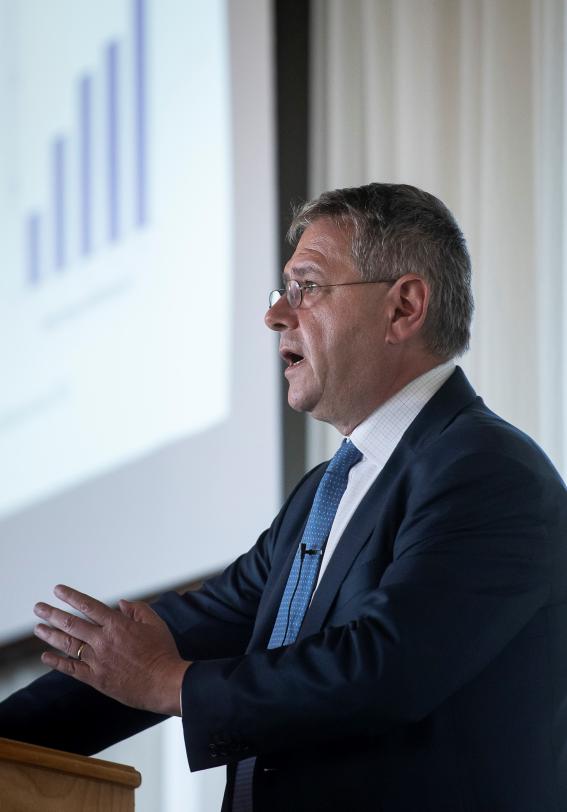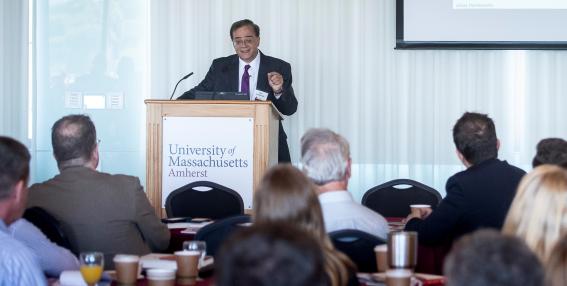Global Financial Crisis Revisited: CISDM Conference Examines What We Learned
October 29, 2018
Ten years ago, the globe was gripped in a historic financial crisis. Markets crashed, entire countries defaulted – Greece is still reeling from the effects -- and the event forced major policy shifts that have shaped the financial landscape across the globe. This was the topic of presentations and discussions at the Isenberg School of Management’s annual CISDM conference on October 4.
Each Fall, the Center for International Securities and Derivatives Markets (CISDM) at the Isenberg School of Management hosts a conference. This year’s event, entitled “The 2007-2008 Global Financial Crisis Revisited”, commemorated the 10th anniversary of the crisis. Five esteemed presenters from academia and the Federal Reserve Bank of New York explored its origins, outcomes, and responses by government and the financial industry. Through presentations and discussions, the gathering examined how the crisis affected behavior and altered analytical frames of mind. And it dissected perennial CISDM concerns, including rationality, market liquidity, derivatives, and financial institutions. The conference also underscored the Center’s mission to connect alternative investments with public policy issues. Past annual conferences have targeted climate change, financial innovation, social entrepreneurship, and other adventurous themes.

An Unremarkable Crisis Mechanism
Not only was the crisis predictable, but as crises go, it proved “very standard,” sandwiched between a credit/optimism bubble and recession. The accelerated growth of credit, Shleifer continued, was and should continue to be a key predictor—a storm warning. Fast-rising household credit coupled with runaway mortgage-backed securities were conspicuous culprits. At the same time, corporate debt and bank equity prices both moved north. In 2006, subprime mortgages peaked at 23.5% of mortgages written that year. They typically account for 11%, noted Schleifer. Excessive optimism about the continued rise of home prices proved the key driver, he said.
The first overt trouble emerged in the summer of 2007 with an asset-backed paper crisis, quickly stabilized by the Fed. By the time Lehman went under in September of 2008, economic fundamentals had for a year intimated the fragility of the financial system, Shleifer emphasized. Lehman was pivotal because it graphically revealed underappreciated tail risks (by both investors and policy makers) and a reluctance to pressure banks to raise capital aggressively. Moreover “Lehman was not some stand-alone phenomenon but part of an interconnected financial system [connected via derivative contracts, fire sales, and other instruments],” he observed.
“The U.S. reacted quickly, saving the financial system but not the economy,” he continued. “Policy was fantastic after Lehman, behind the curve before it.” In the latter, he added, neglect of downside risks and high expectations in the housing market proved crucial. And driving it all was a constellation of counterproductive beliefs—assumed and unquestioned.
A Tale of Two Recessions
Gikas Hardouvelis offered an international take on the recession. A professor of finance and economics at the University of Piraeus in Greece, Dr. Hardouvelis was its Minister of Finance from June 2014 until January 2015. “What we call here (the U.S.) the Great Recession was in fact a worldwide recession,” he remarked. The United States, he noted, endured crises of its banking system and economy. Europe also suffered those calamities and a third—a crisis of sovereign debt. In the latter, Greece occupied center stage. The country went bankrupt. “In practice, it did default.”

A North/South Fandango
“When you look at the European Monetary Union’s (EMU) aggregate statistics on macroeconomic imbalances, you cannot detect a problem, as they look even better than the U.S. statistics before the crisis,” Hardouvelis told the gathering. Yet those aggregate numbers hid a significant internal cohesion issue. Indeed, several individual countries in the South, including Spain, Portugal, and Greece, performed extremely poorly. The formation of the EMU, in time, led to a very competitive North and a noncompetitive South. Unfortunately, after the Euro’s introduction, the former national currencies and their exchange rates would no longer serve as checks against those imbalances. Early on, observers thought of Portugal, Spain, and Greece as “little Germanys,” he added. “But the Greek crisis woke everybody up, raising eyebrows.”
For EU policy makers, “Greece evoked Italy in their minds,” he continued. They feared that Italy might be next. With that said, the EMU rushed to rescue Greece in May of 2010. But by October, Germany and France had changed their tune. “We’re not going to rescue EMU countries again at any cost,” they warned private bond holders. Moving forward, countries would have to rely on “bail-ins,” not bailouts.
During the 2010-2013 crisis, “Europe, in fact, never really made up its mind, being torn between two separate goals—those of current crisis mitigation and future crisis prevention,” Hardouvelis explained. “Its actions were always in the middle of those two goals, hence being too little, too late—and behind the curve.” On the positive side, the EMU did introduce a Europe-wide stability mechanism and a monetary backstop via outright monetary transactions. It also established an unfinished Banking Union (a weaker version of the Fed) and a variety of stricter fiscal rules. But to date, the EMU has failed to initiate fiscal transfer mechanisms. In contrast to the United States, “Europe has no political union and no large central budget.” And citing an old policy argument between France and Germany, Hardouvelis remarked that the French had won out. They pushed their will to establish the EMU first, hoping it would organically lead to the desired political union over time.
Continued Challenges for Greece

More Timely Presentations
Three additional presenters rounded out the CISDM conference. Anna Kovner made a persuasive case for the accuracy and value of regulatory stress tests of U.S. banks. Dr. Kovner is Vice President and Policy Leader for Financial Stability at the Federal Reserve Bank of New York. Devised by the federal government at the apex of the financial crises, the tests, which come in two principal varieties, reveal when banks have failed to conserve sufficient capital to meet potential financial threats. In addition to encouraging proactivity at the banks, the tests are themselves forward looking, focusing on downside financial risk, including worst-case scenarios. Their detailed, rich data also have value for CFOs and investors.
Ricardo Caballero, Ford International Professor of Economics at MIT, advocated a risk-centric macroeconomic approach to understanding global economic events, including the Great Recession. To that end, he emphasized the role of safe assets, defined as assets that preserve much of their value during large system events. Dr. Caballero surveyed their supply, demand, and differential international flows. He charted their implications for stocks and prices. And he noted their acute shortage in crises and role in panics and “safety traps.” The demand for safe assets by China and other emerging nations, he emphasized, was a key driver in trade imbalances with the U.S. That’s because buying those assets required trade surpluses with the U.S.
Financial firms benefit when employees identify more strongly as stakeholders, observed former New York Fed Assistant Vice President Hamid Mehran. One ingredient in that approach, he said, would be to introduce deferred cash compensation with features of performance bonds. In a downturn, employees would forgo their deferred cash. Acting as insurance, the arrangement would increase the likelihood of job longevity with the firm. And endowing employees with greater stakeholder status would likely enhance their motivation.









